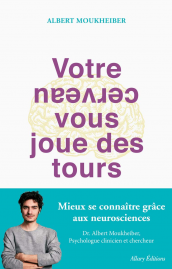Our brain, the great culprit?
Interview with Albert Moukheiber

Albert Moukheiber looks at the human factor in solving today's environmental challenges. What is it about our brain that makes it difficult to take action despite a high level of information on the subject? How to analyse the gap between our intentions and our actions? Conversely, what happens in the brains of eco-anxious people?
INTERVIEW
Sustainability MAG: For some years now, you have been receiving a new type of patient which particularly appeals to you: the eco-anxious. Who are they?
Albert Moukheiber: I cannot say whether there is a typical profile of eco-anxious or solastalgic people. However, I observe common ideological and political tendencies among my patients. They are people who are more concerned about the climate crisis. The issue is that they can't disengage from the subject and move on. We're talking about a significant level of disability here. Solastalgia modulates the whole psychic apparatus. It is not only a question of anxiety or stress. It also profoundly impacts habits, social cognition and professional life. It is not rare for my patients to consider a professional reorientation to a job they think holds more sense. They also fundamentally question their lifestyles and the people's values in their social circle. We frequently observe resentment towards people close to them. Solastalgia structures the personality and reorganises all aspects of life.
"Solastalgia modulates the whole psychic apparatus. It also profoundly impacts habits, social cognition and professional life."
What is different about this condition compared to the ones you have been treating? Does it represent a clinical challenge?
It is a challenge in the way that solastalgia differs from the anxiety disorders as we know them so far, which correspond mainly to two cases. In many cases, it is a matter of excessive anxiety about things that are not genuinely dangerous. Social phobia, for instance, is the fear of being judged by other people. The person will think that he or she is being judged negatively, although this isn't usually the case. The same applies to arachnophobia or claustrophobia. With solastalgia, the fear of global warming is very legitimate, considering the current scientific knowledge. It represents a real danger. Therefore, it is not possible to work in therapy on a cognition reorganisation. Ethically, it is impossible to tell the patient that everything will be fine. That his or her fear is unjustified. This is an excessive fear of a realistic danger, almost an existential one.
In fact, this is an adjusted pathology. It can be compared to the second case that we find with adaptive depression. A typical example is a toxic relationship where the problem comes from outside. In this situation, we focus in therapy not on getting the patient to adjust his or her perception and get better but rather on getting him or her to end the toxic relationship.
Studies are beginning to emerge on treating solastalgia. What do they reveal?
They often focus on intentional disengagement. It consists of recognising the danger as a reality but seeking to prevent the patient from being paralysed by this issue in day-to-day life. The intention is to maintain functionality despite the legitimate fear. For example, helping the patient to understand that removing oneself from social relationships is not what will change the problem. It is rather an illusion of action. These supportive therapies already exist, but their methods have been adapted to the subject of climate change.
Let's focus on one of the causes of this anxiety, namely our collective inaction in the face of an alarming situation. From the neuroscientist's point of view, what explains our inability to act?
It is a complex subject, and there are several factors. We have to separate the individual elements from the collective ones.
On the individual level, multiple biases explain this inaction. We can mention the optimism bias, the difficulty in changing habits, or the present moment bias. There is also the illusion of knowledge - we think we know the subject when we don't -, techno-solutionism - we don't worry because technology, we believe, will solve everything -, acquired helplessness - we have made efforts, but with no apparent result, so we stop acting -, or the social norm bias - we do what others do, and they don't change their habits.
However, all this is somewhat secondary to the more systemic and structural factors linked to our society's model of consumption. We want to reduce our air travel, but the low-cost airlines are always cheaper. We want to reduce our electronic use, but we are surrounded by advertisements for the latest phones on the market... it will be challenging. Our cognitive biases remain, above all, contextual.
"Our cognitive biases remain, above all, contextual."
Can we turn things around by playing on our biases? Are nudges designed to encourage a change in behaviour through small tricks efficient?
Nudges are efficient in very limited contexts. Often, their effects fade away after a while. It is a faulty solution. Yes, it's interesting to have these nudges so that we throw our cigarette butts in the right place or avoid taking too much paper in the toilet, but in my opinion, these are illusions of action. They will not solve the situation we are in. And more importantly, there is a risk of rebound effects: these small actions may give the impression that one is already doing enough and thus can afford a flight to Peru! A more systemic response is needed.
It is essential to influence the individual's perceptions to a large extent so that the shift to systemic change, via the legislative tool, for example, is adopted. For instance, a law banning smoking in public places would not have been well received by the population if they had not been made aware of the dangers of smoking beforehand. Once the educational phase and the understanding of the issues at stake at the individual level are achieved, a change in standards must be triggered. Regarding climate change, this awareness is already there; surveys clearly highlight people's concerns about the subject. It is, therefore, time to instil a systemic change.
In conclusion, systemic factors play a more important role than individual factors. So our brain is not the great culprit
Not at all! It is not our brains that are to blame. It's not our striatum's or our neurotransmitters' fault, as some people might claim! If it were our brain's fault, we wouldn't be able to stop smoking, get into sports, or ensure a good diet... because there are many common biases at play. Such an approach can be qualified as biological reductionism. It places too much emphasis on the individual's intrinsic limitations. The over-valuation of the individual scale makes systems invisible.

Albert Moukheiber
Albert Moukheiber holds a PhD in cognitive neuroscience and works as a clinical psychologist. He is also a member of ACTE LAB, a group of researchers working on the behavioural approach to the ecological transition. Furthermore, he is a co-founder of the CHIASMA collective dedicated to analyse opinion-making.


